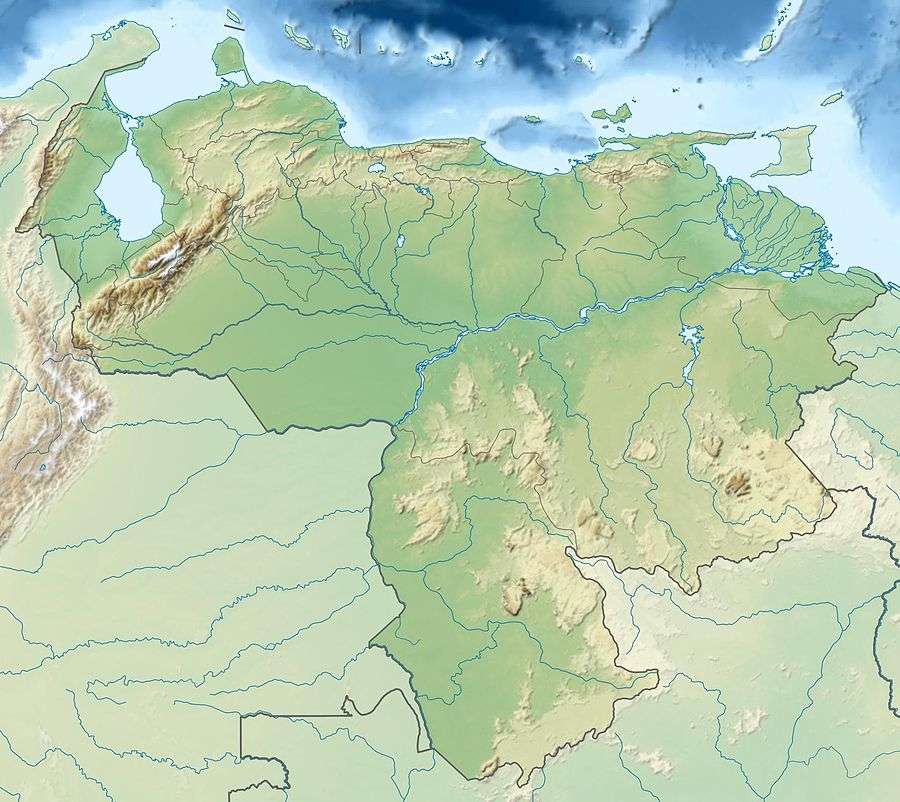Cerro Duida
| Cerro Duida | |
|---|---|
 Cerro Duida (background) as seen from La Esmeralda | |
| Highest point | |
| Elevation | 2,358 m (7,736 ft) [1] |
| Coordinates | 03°30′48″N 65°37′34″W / 3.51333°N 65.62611°WCoordinates: 03°30′48″N 65°37′34″W / 3.51333°N 65.62611°W |
| Geography | |
 Cerro Duida Location in Venezuela | |
| Location | Amazonas, Venezuela |
Cerro Duida, also known as Cerro Yennamadi, is a very large tepui in Amazonas state, Venezuela.[1] It has an uneven and heavily inclined plateau, rising from highs of around 1,300–1,400 metres (4,300–4,600 ft) in the north and east to a maximum of 2,358 metres (7,736 ft) on its southwestern rim.[1] It has a summit area of 1,089 km2 (420 sq mi) and an estimated slope area of 715 km2 (276 sq mi).[1] At its foot lies the small settlement of La Esmeralda, from which the mountain can be climbed.[2]
Cerro Duida shares a common base with the much smaller (but taller) Cerro Marahuaca, located off its northeastern flank, and together they form the Duida–Marahuaca Massif.[1] Both tepuis are entirely within the bounds of Duida–Marahuaca National Park. Sandwiched between them, a massive ridge known as Cerro Petaca rises to at least 2,700 metres (8,900 ft). The much lower Cerro Huachamacari, derived from a separate base, lies to the northwest of this complex.[1]
Tyler-Duida expedition
George Henry Hamilton Tate led a major expedition of the American Museum of Natural History to Cerro Duida in 1928–1929.[2][3] Named the Tyler-Duida Expedition, it was the first to reach the mountain's summit plateau and the first to climb a tepui of the Venezuelan Amazon.[4] Mount Duida frog was first collected during the expedition and is still not known from anywhere else, although it was formally described only 40 years later.[5][6] Although primarily a zoological expedition, much plant material was collected.[3] These herbarium collections were studied extensively by Henry Gleason, who formally described many of the mountain's plant species in a series of papers published in 1931.[7][8][9][10] This was followed by a number of important botanical explorations of Cerro Duida, first by Julian A. Steyermark in 1944 and later by Bassett Maguire in 1949 and 1950.[3][4]
See also
References
- 1 2 3 4 5 6 Huber, O. (1995). Geographical and physical features. In: P.E. Berry, B.K. Holst & K. Yatskievych (eds.) Flora of the Venezuelan Guayana. Volume 1. Introduction. Missouri Botanical Garden Press, St. Louis. pp. 1–61.
- 1 2 Tate, G.H.H. & C.B. Hitchcock (January 1930). The Cerro Duida region of Venezuela. Geographical Review 20(1): 31–52. JSTOR 209125
- 1 2 3 Huber, O. (1995). History of botanical exploration. In: P.E. Berry, B.K. Holst & K. Yatskievych (eds.) Flora of the Venezuelan Guayana. Volume 1. Introduction. Missouri Botanical Garden Press, St. Louis. pp. 63–95.
- 1 2 Huber, O. (1995). Vegetation. In: P.E. Berry, B.K. Holst & K. Yatskievych (eds.) Flora of the Venezuelan Guayana. Volume 1. Introduction. Missouri Botanical Garden Press, St. Louis. pp. 97–160.
- ↑ Rivero, J. A. (1968). "A new species of Elosia (Amphibia, Salientia) from Mt. Duida, Venezuela". American Museum Novitates. 2334: 1–9.
- ↑ Frost, Darrel R. (2015). "Dischidodactylus duidensis (Rivero, 1968)". Amphibian Species of the World: an Online Reference. Version 6.0. American Museum of Natural History. Retrieved 29 August 2015.
- ↑ Gleason, H.A. (May 1931). Botanical results of the Tyler-Duida Expedition. Bulletin of the Torrey Botanical Club 58(5): 277–344. JSTOR 2997213
- ↑ Gleason, H.A. (June 1931). Botanical results of the Tyler-Duida Expedition. Bulletin of the Torrey Botanical Club 58(6): 345–404. JSTOR 2480734
- ↑ Gleason, H.A. (October 1931). Botanical results of the Tyler-Duida Expedition. Bulletin of the Torrey Botanical Club 58(7): 405–464. JSTOR 2480424
- ↑ Gleason, H.A. (November 1931). Botanical results of the Tyler-Duida Expedition. Bulletin of the Torrey Botanical Club 58(8): 465–506. JSTOR 2480621